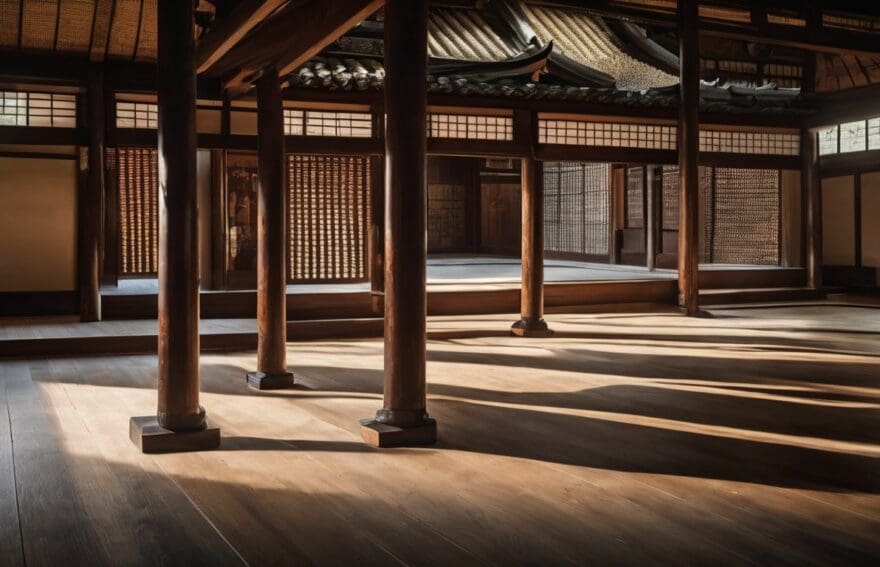The Art of Combat: Aesthetic Appeal in Fighting Games and the FGC

Updated On: February 28, 2024 by Aaron Connolly
Many of us find ourselves entranced by the dazzling manoeuvres and vibrant visuals on display in our favourite fighting games, but the gripping reason behind this fascination often eludes us.
We’ve all savoured that surge of satisfaction when pulling off a flawless combo or gazed in wonder at a game’s richly designed universe; indeed, research suggests these visual elements play a significant role in shaping our gaming experience.
Our upcoming piece delicately unravels the intricate ways aesthetics elevate each punch and kick delivered within these captivating virtual worlds. Ready your senses to explore an arena where artistry and battle effortlessly merge!
Key Takeaways
- Fighting games blend intricate character designs and flashy combos with cultural influences from both Japanese and American traditions, resulting in a vivid aesthetic that captivates players.
- The FGC (Fighting Game Community) thrives through local tournaments, online play, and forums, fostering social interactions that build camaraderie and skill development among gamers globally.
- Evolving from arcade origins to home consoles has allowed fighting games to offer more complex visuals and gameplay, which in turn have become key features for immersion in these competitive titles.
- Professionalisation within the FGC due to the rise of esports has led to increased sponsorships for players and the integration of fighting games into mainstream gaming events.
- Soundtracks and sound effects are pivotal in fighting game aesthetics; they create an energising atmosphere that complements dynamic visual elements enhancing player immersion.
The Evolution of Fighting Games
Fighting games have come a long way from their origins in arcades to becoming a staple in home consoles. With the rise of the FGC (Fighting Game Community), these games have become a blend of Japanese and American cultures, shaping the competitive gaming landscape.
From arcades to home consoles
We’ve watched the transition of fighting games from the bustling energy of arcades to the comfort of our living rooms. The shift wasn’t just about location; it transformed how we play and engage with these competitive masterpieces.
Home consoles brought a new level of accessibility, allowing us to dive into complex battle mechanics and stunning character designs anytime we wanted. With this change, visuals played an even more crucial role as game aesthetics evolution became integral for an immersive home gaming experience.
The leap to home consoles also meant that high-quality graphics could now be enjoyed in full glory on bigger screens. Characters once confined to pixelated sprites were reborn into muscular 3D models showcasing martial arts moves with fluidity and grace seldom seen outside professional tournaments.
It opened up a world of strategic gameplay where execution difficulty was balanced with visually impressive combos and special moves, each designed not only for impact but also for visual spectacle – enhancing both our skill development and aesthetic appreciation simultaneously.
The rise of the FGC (Fighting Game Community)
The Fighting Game Community (FGC) has grown exponentially in recent years, evolving from small local gatherings to massive global events. The FGC is built on the passion and dedication of its members, who come together to celebrate their love for fighting games.
This community has created a space for players of all skill levels to connect, compete, and share strategies. With the rise of online platforms and social media, the FGC has become more accessible than ever before, allowing gamers from around the world to join forces and showcase their talents.
As the FGC continues to expand, it has had a profound impact on the gaming industry as a whole. The community’s support and enthusiasm have elevated fighting games into a prominent position within the realm of esports.
The influence of Japanese and American cultures
The influence of Japanese and American cultures is evident in the visual design and gameplay mechanics of fighting games. Japanese aesthetics often emphasise intricate character designs, fluid animations, and visually stunning special moves.
On the other hand, American influences can be seen in the emphasis on brute strength, muscular character models, and intense combat environments. These cultural influences contribute to the diverse range of visual styles and gameplay dynamics found in fighting games, catering to a wide audience with varied aesthetic preferences.
Understanding these cultural influences adds depth to our appreciation of fighting game aesthetics while also highlighting the global appeal of this genre. The fusion of Japanese and American elements creates a rich tapestry that shapes the identity of these games, providing players with an immersive experience that celebrates diverse artistic expressions.
The Aesthetic Appeal of Fighting Games
Fighting games have always been known for their visually striking and diverse character designs, as well as the intricate and flashy special moves and combos that players can execute.
The stage designs, soundtrack, and sound effects also play a crucial role in creating an immersive experience for players. These aesthetic elements contribute to the overall appeal of fighting games within the FGC community.
Character designs
Character designs in fighting games are crucial to the overall visual appeal, contributing significantly to the game’s identity and immersive experience. The muscular 3D models of characters showcase the attention to detail put into their creation, enhancing the aesthetic quality of the game.
Additionally, character designs are essential for helping players understand each fighter’s unique abilities and play style. These visually striking designs not only add to the excitement of battles but also help create an engaging and memorable gaming experience.
The racialised histories of Black Americans have influenced the character designs in fighting games, adding a sense of authenticity and diversity to the roster. From distinct costumes to varied body types, these diverse character designs contribute to making fighting games more inclusive and representative of different cultures.
Combos and special moves
Combos and special moves are essential elements in fighting games, allowing players to string together a series of attacks for devastating results. Mastering these intricate sequences requires skill, timing, and precision.
The execution barrier for pulling off complex combos adds an additional layer of challenge that appeals to competitive gamers seeking mastery. Visually stunning special moves not only deal significant damage but also contribute to the overall aesthetic appeal of the game.
The dynamic animations and effects associated with each character’s unique abilities add depth and excitement to gameplay, enhancing the immersive experience for players.
The visual design of combos and special moves is crucial in conveying the power and impact behind each attack. Muscular 3D models flex their strength as they execute powerful strikes, accompanied by impressive visual effects that amplify the intensity of combat.
Stage design
Stage design in fighting games plays a crucial role in enhancing the overall aesthetic appeal and gameplay experience. The visual elements of stages, such as background animations, dynamic environments, and interactive features, add depth and immersion to the game.
By integrating elements that complement the characters’ abilities or interact with their moves, stage design can effectively contribute to strategic gameplay.
Furthermore, the diversity of stage settings and themes not only adds variety but also enriches the narrative and cultural representation within fighting games. From urban landscapes to mystical realms, each stage showcases unique artistic styles that captivate players and contribute to the identity of the game.
Soundtrack and sound effects
The soundtrack and sound effects in fighting games are crucial elements that contribute to the overall immersive experience. The high-energy music sets the tone for intense battles, adding an extra layer of excitement to gameplay.
Furthermore, well-designed sound effects enhance the impact of each punch, kick, or special move, providing immediate feedback to players and making every action feel impactful. This attention to auditory details not only complements the visual aspects of the game but also plays a significant role in shaping the identity and atmosphere of fighting games within the gaming community.
The combination of dynamic soundtracks and impactful sound effects heightens the emotional engagement of players with their chosen characters and intensifies the adrenaline rush during combat.
Moreover, as esports competitions continue to gain popularity, carefully crafted audio elements add another dimension to spectator experiences by creating an electrifying ambiance that resonates with both players and viewers alike.
The Role of Social Interactions in Fighting Games
Social interactions have always been a significant aspect of the fighting game community. From the local gatherings and tournaments to online play and forums, social gaming has created a sense of camaraderie and competition among players.
This aspect of the FGC has helped shape the culture of fighting games and has contributed to their enduring popularity.
The community aspect of local tournaments and events
Local tournaments and events provide a platform for gamers to come together and showcase their skills in a competitive yet supportive environment. The community aspect of these gatherings fosters camaraderie and sportsmanship among players, creating an electrifying atmosphere that fuels their passion for the game.
- Enthusiastic participants engage in friendly banter and share strategies, building connections and friendships within the gaming community.
- Players actively support and encourage each other, fostering an inclusive environment that welcomes all skill levels.
- Attending events allows gamers to learn from one another, exchange tips, and techniques, ultimately honing their gameplay prowess.
- Spectators add to the lively ambience, cheering on their favourite players and immersing themselves in the excitement of the matches.
- Gamers collaborate to organise events, contributing to a vibrant local gaming scene that thrives on mutual respect and collaboration.
Online play and forums
Transitioning from the community aspect of local tournaments and events, online play and forums have become integral to the Fighting Game Community (FGC). Gamers from around the world can connect, compete, and learn from one another through online platforms.
These digital spaces provide a platform for players to showcase their skills, discuss strategies, and form alliances with like-minded enthusiasts. Online forums serve as hubs for sharing content, hosting discussions, and organising virtual meetups where gamers can engage in friendly competition or seek advice on improving their gameplay.
The accessibility of online play has expanded the reach of fighting games beyond local communities and enabled players to participate in international competitions without leaving their homes.
The Impact of the FGC on the Gaming Industry
The rise of the FGC has had a major impact on the gaming industry, leading to the growth of competitive esports and the professionalisation of fighting game players. This has resulted in sponsorships and the integration of fighting games into mainstream gaming events, solidifying their place as a key genre in the gaming world.
The rise of esports
Esports has seen a significant surge in popularity within the Fighting Game Community (FGC). Competitive gaming events, such as EVO (Evolution Championship Series) and Capcom Pro Tour, have elevated fighting games to professional levels, drawing in large audiences and offering substantial prize pools.
Professional players now compete on global stages, showcasing their skills and strategies in popular titles like Street Fighter, Tekken, and Super Smash Bros.
The integration of fighting games into mainstream esports competitions has attracted attention from major sponsors and organisations. This rise of competitive gaming has not only increased the visibility of the FGC but also brought about new opportunities for aspiring professional players.
Sponsorship and professional players
Sponsorship plays a pivotal role in the world of fighting games, providing professional players with opportunities to excel and make a living from their passion. Companies often invest in top players, offering financial support and resources to help them compete at the highest level.
These sponsorships can cover travel expenses, equipment, and even provide salaries for the most elite competitors.
Professional players in the FGC are highly sought after by major gaming brands due to their skill, influence within the community, and ability to attract audiences. As a result, they embody an essential aspect of the industry’s growth and vitality.
The rise of esports has further elevated these opportunities for professional players within the fighting game scene.
The integration of fighting games into mainstream gaming events
With the growing popularity of esports and the professionalisation of fighting games, we have witnessed an increasing integration of these games into mainstream gaming events. Major gaming conventions and tournaments now feature dedicated spaces for fighting game competitions, attracting both players and spectators alike.
This inclusion has not only diversified the range of games showcased at such events but has also highlighted the competitive nature and visual spectacle of fighting games. The presence of these titles in mainstream gaming events reflects their unique appeal to a wide audience while contributing to the overall growth and recognition of the Fighting Game Community (FGC).
The visual design and intense gameplay found in fighting games have helped them transcend traditional niche audiences, gaining widespread acceptance within diverse gaming communities.
Consequently, this integration has broadened the visibility and appreciation for different styles of play, character designs, soundtracks, and strategies present in various fighting game titles.
Conclusion
In conclusion, the aesthetic appeal of fighting games is a crucial aspect that enhances the overall gaming experience. Character designs, special moves, and stage design all contribute to creating an immersive and visually captivating game environment.
The integration of visually striking elements with solid gameplay mechanics is essential for the success of modern fighting games. It’s evident that visual design plays a significant role in shaping player identity and enhancing their engagement with the genre.
Embracing the artistry within combat-based video games continues to be pivotal in attracting new players and retaining dedicated fans alike.
FAQs
1. What makes the art of combat important in fighting games?
The Art of Combat enhances the aesthetic appeal, with muscular 3D models and vivid video game art setting the stage for an immersive gameplay identity.
2. How does performativity fit into fighting games and the FGC?
Performativity in fighting games allows players to express themselves through social gameplay within the Fighting Game Community (FGC), showcasing their style and strategy.
3. Can video game art impact how we play fighting games?
Absolutely! Video game art isn’t just for show; it shapes our experience, influences our strategies, and helps define our unique presence within the game performance.
4. Is there a relationship between aesthetic appeal and community in fighting games?
Yes, there is a strong link—eye-catching visuals draw players together, creating shared interests that strengthen bonds within the FGC while enhancing overall enjoyment during social gameplay.


